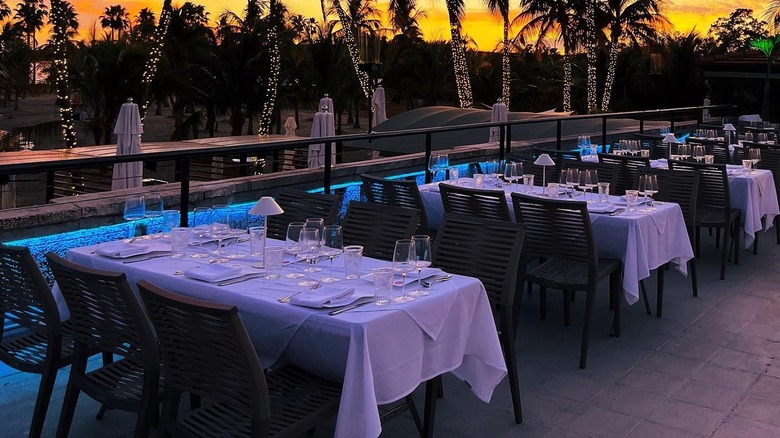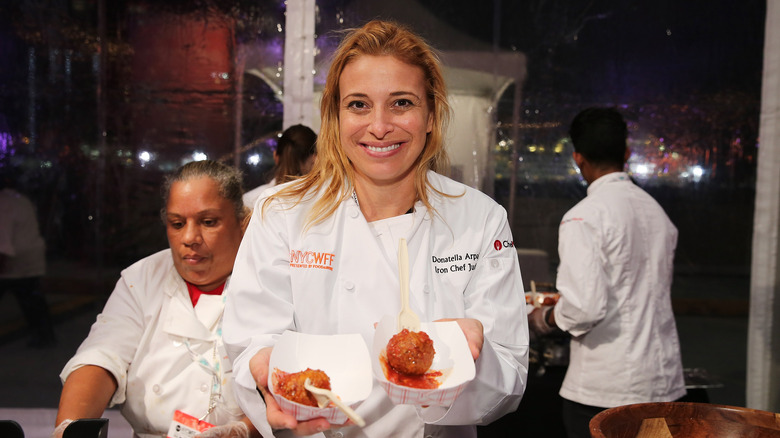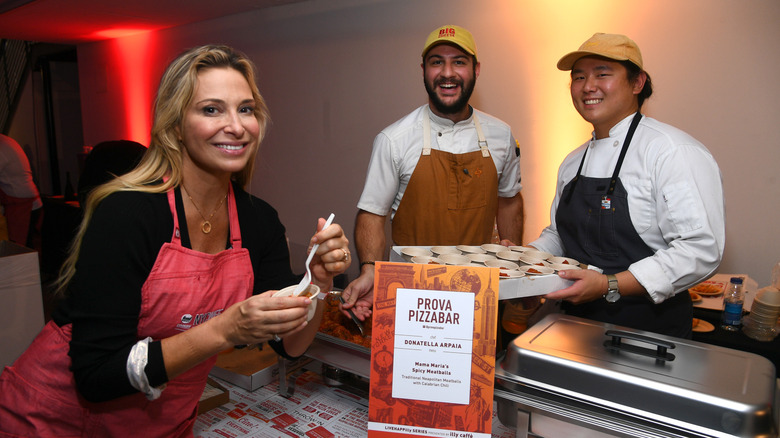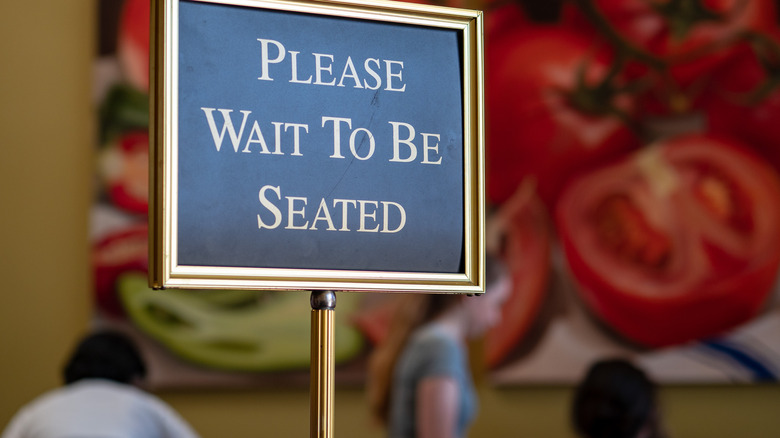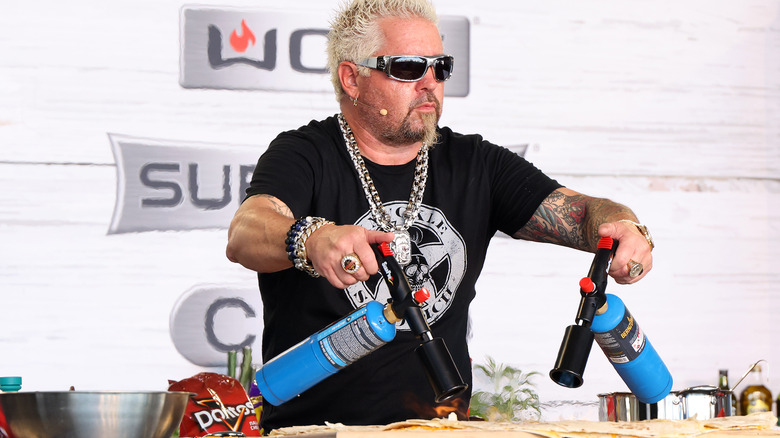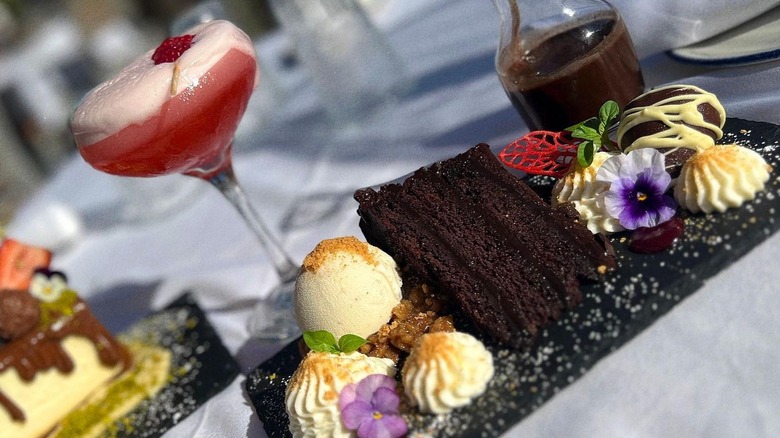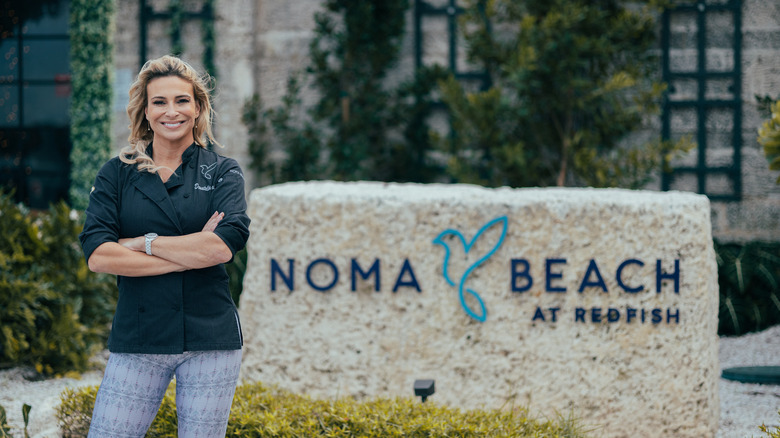Donatella Arpaia Discusses Bringing The Flavors Of Home To Noma - Exclusive Interview
Donatella Arpaia is back with her first new restaurant after moving to Florida over four years ago. Though not her first restaurant in the state, Noma Beach at Redfish is something close to Arpaia's heart. She may have started her career as a lawyer, but she felt pulled back into the restaurant world that she grew up in, even going back to school and earning a culinary degree. With this unique background, Arpaia brings her passion, knowledge, and uncanny business savvy to each of her projects in the food world.
Whether it is running restaurants, judging on "Iron Chef America," or writing cookbooks, Arpaia always has something in the works. We caught up with her for an exclusive interview, where she told us all about Noma Beach and what makes it special, while also providing insight into the food world at large. We even got the "queen of meatballs" to spill her best tips on how to make her award-winning dish.
What diners can expect at Noma Beach at Redfish
You recently opened Noma Beach at Redfish, which was the Redfish Grill before you took over. With your impressive and varied restaurant background, what were your goals with the new menu?
When I found the location, I immediately thought about my summers spent in Italy. I grew up in Puglia and Naples, which is the coast, so I thought about coastal Italian cuisine. I thought about crudo right away — which is the raw Italian fish — a huge crudo bar. I definitely wanted to meld with the environment, and I thought local and seasonal. Being a Miami native now for four and a half years and coming from New York, I remember thinking, "Wow, I'm going to find a lot more fresh local fish," [but] I would dine at restaurants and find that there wasn't a lot of fresh local fish. Everyone was getting imported frozen fish.
I wanted an emphasis on fresh local seasonality, which is the basis of Italian cuisine, but through here. There's so many seasons here. There's a local spiny lobster season, stone crab season. I'm learning all about the fish here. Also, there's beautiful cuts of steak.
Redfish Grill has been around. There's a lot of confusion around what it is — it's going to take a while for people to know that we're focusing on fresh food, whereas before, the space was more known for ... You go for the location, and the food was more of an afterthought. But here, I'm trying to bring great quality food, and there's a big bar scene and a beautiful outdoor bar. I want fresh oysters. I want seasonal drinks. You're in the sun, so you want to think about the things that you want to eat when you're outside.
I also have homemade pasta. We have an Arcobaleno machine, so we make all our pasta in-house, all our pastries in-house. It's quite a little motor for that place.
I always see Noma Beach, because Noma is named after my twins. It's like Noah and Emma ... I see it as an extension of my home. This is the kind of food that I would cook when I'm at home, as opposed to through the years doing different concepts.
Arpaia's award-winning meatballs
Your award-winning meatballs are on the menu. When you make meatballs, what is your preferred meat blend and why?
[laughs] The million-dollar question. I've tried many, many different versions. The version my mother did was all beef. When I won my awards in the New York City Wine & Food Festival, it was all veal. Right now, I am doing a blend of veal, beef, and a little bit of pork, but very little.
It's not only about the blend. People always talk about, "Why are your meatballs constantly winning?" It's extremely labor-intensive, and I follow the method that my mother and grandmother taught me, which is small batch. I do it in small batch cooking, and only fresh ingredients. We don't take any shortcuts. I pan-fry them for the golden crust, which most restaurants don't. They either bake them, or they boil them, or ... It's very time-consuming. It's very labor-intensive and time-consuming, but I'm very committed to them. That's why people come back for it all the time. It's a lot of love in my meatballs.
What's one mistake that people often make when making meatballs at home?
A lot of mistakes. First of all, they use a lot of not fresh ingredients — like for minced garlic, they'll use garlic powder. They'll use dried herbs instead of fresh herbs. I use fresh garlic; I use fresh herbs. The quality of meat is important. Ground meat in general is not expensive, so go for the hormone-free, go for better-quality ground meat, not too fatty. Also, I pan-fry mine for that golden crust. I also use bread. I don't use breadcrumbs ... Lots of tricks. I don't know if I should give you all of them.
Home cooks also think the more meat, the better; the bigger, the better. I think proportion size is very important. Too tiny, and it can be all crust, and too large, it's like ... We're not making meatloaf, we're making a meatball. Americans sometimes say, "The bigger, the better," and I don't think that's the case with meatballs.
Some things take time. When I grew up, and [for] most Italians that came from Italy, on a Sunday, we woke up to the smell of garlic and onions, not bacon and eggs. It's because our moms or grandmothers were making the meatballs for the day, and it would take five, six hours to make. It's a beautiful process and one that's why everyone wants to always come to Italians on Sunday, but it took time. You fry the meatballs first, and we'd go to church and we would steal the meatballs before going to church. I like them just fried, too, before they even go into the sauce.
Then the sauce takes time. You have to put it on a very low simmer to acquire all that taste, and [get] good quality San Marzano tomatoes if you can. Even local tomatoes, as long as they're ripe, are wonderful too.
Perfect pizza
Speaking of time, on the Prova Pizzabar website, it states you use the longest proofing time and high water content. What do those things add to a pizza crust?
Prova pizza is a Roman-style pizza. When you have high water [content], it's like the square pan-style pizza. It looks like a grandma pie, but it's not a grandma pie because it's not thick and dense and heavy ... You're going for crispy and chewy at the same time.
If you ever have a New York City dollar slice of pizza, they're constantly producing it by putting a lot of yeast in it. The process of fermentation occurs inside your body instead of outside. That's why if you have bad pizza and you drink a glass of water, your stomach blows up, because the yeast is fermenting inside you. But when you use very, very little yeast and you let it rise over a long time, not only [does it] result in a highly digestible pizza, but it also results in a richer, deeper-profile taste to the pizza.
[It] really is a science, pizza. It is science and art. I always say the science is in the bread and the art is in the creativity that you do with your toppings and stuff.
When you make a pizza sauce, what's the secret to that, and how is it different than other sauces?
It depends on the type of crust. Neapolitan pizza, for example — which is one of the things I've studied the most — less is more. It's often a fresh tomato puree, maybe a touch of sea salt, and maybe one garlic ground up in it. It's cooked only slightly, but it's almost raw. The simplicity of that is beautiful because the Neapolitan crust cooks in 90 seconds, and it's so light and airy — just a little sauce. But if you go to deep-dish-style pizzas, they could take on a sauce that's much more robust or toppings that are more robust.
It depends on the kind of pizza because there's so many kinds of pizza today. It doesn't end. But in general ... the Italian style is less is more. If you're starting with the best ingredients, you don't want to corrupt it. I don't like these sauces that have this metallic taste to it or [are] over-seasoned ... I hate sugar in the sauce. I hate that. That's something that if you speak to Italians, they will look at you with disgust if you consider putting sugar in your sauce or stuff like that.
Arpaia's front of house expertise
In the early days when it was David Burke & Donatella, you were in charge of front of house. How did you make sure that the front of house ran smoothly?
I definitely love to welcome people in my restaurant, and it's such a lost art and hard to replicate. When you have that sense of service, it's really important ... When we talk about service, whether it's fine dining or quick service, it's all about the personal touch and caring.
That's what people remember, because you can go to the best restaurant where technically everything is perfect, but you're left cold. You can go to a restaurant where maybe nothing was perfect that night — because you can't always be perfect all the time, as much as we strive to — but you'll remember whether there was care in terms of knowing your name, whether there's care in terms of how you're treated at the door, which is so important. Still, one of the most neglected places is greeting people, making them feel at home, caring.
I'll give you an example. I have toddlers, so I understand what it's like to be a mom at a restaurant. There's a thing where if you have young kids, when you place the order, my servers know that they're going to tell the parents that their food comes out first because the kids want to eat, and if they don't eat, the parents can't eat. That's little things, but it's done in a gesture. I always have crayons and I always have placemats, and I have a little treasure box at the end where they can go and get something out. These little touches are things that a parent will remember [and] a child remembers.
I always say if you give quality food, good service, and you care — and you do it on a consistent basis — the rewards are going to keep coming back to you. The gimmicks don't last. They don't.
60% of new restaurants close within a year and 80% close within five years. What does it take for a restaurant to last through that first year or first five years?
It's so hard. There's so many variables. [For] a lot of the new timers, new people in the restaurant business, it's hard to understand what experience can give you. A lot of times, people are ill-prepared for outside business forces that you have no control over, and they don't have ... You should hopefully have a cushion of money to start with, because you need a cushion sometimes. That can be something where many, many restaurants that close maybe wouldn't have closed if they could ride out certain things that occur that are beyond their control in the beginning. But you don't know what can happen.
Then, people don't understand that the restaurant business is actually business. It's part of that. [You need] to have a sound business plan, to create good assumptions, and to understand, and then to adapt and change accordingly if you need to. Some people think as long as you have good food or good service, it's enough, and it's not. You have to have all those components, and you have to be able to adapt.
Restaurant red flags
When you go out to eat at a restaurant, what are some of the first things you notice that tend to raise red flags?
Sometimes the biggest problem is when there's a lack of identity. It doesn't know what it wants to be, and it's trying to cater to too many things. Obviously, cleanliness is huge for me ... That's big. Is the staff generally happy? [Are they] also knowledgeable? I usually can walk into a place and know if it's going to make it or not within the first 30 seconds.
I know. I've been doing this a long time, and I grew up in the business. My father was a well-known restaurateur, and I grew up listening to those conversations too. It's many years of experience that culminate into an impression that you can feel in the moment and the quality of the food I can look at [on] a plate. Besides, from all my knowledge, all my years as a judge of "Iron Chef America," "[The] Next Iron Chef" ...
I've literally eaten the best food in the world, but it doesn't have to be the best food in the world to succeed. It just has to be what it's supposed to be. If you go to a burger joint, you want a good burger. The restaurant needs to tell a story of what it is and then perform what it's supposed to be. If there's that disconnect, that usually means it's not going to work out.
In a recent interview, Guy Fieri spoke about problems in food availability in the restaurant industry and struggling with supply chain issues. Has that impacted your ability to build menus?
Absolutely. It's several [things]. It's not only supply chain issues, it's the cost of everything. It's gotten so expensive, but one of the largest problems that I have is food that tastes like food, especially produce. I can't get a tomato that tastes like a tomato or a berry that tastes like a berry. Finding fresh fish that's not farmed and local is a big problem. You would think that me saying that I want that, [because] I'm in Florida, it would be easy — and it's not. It's very expensive and very inconsistent. When you're committed to being that way, it's a struggle. It's a big struggle today.
The impact of food trends
What are some of your favorite emerging food trends right now?
I guess I'm supposed to say vegan and the meat, but it's not. I don't like them. It's not my favorite ... The food trends that are most important are food that tastes like food. That is a trend, because sourcing foods that are not genetically engineered and local and farmers ... That's going to keep continuing because chefs, especially, are in search of flavor. It's very important.
I think that different ethnic [food traditions] are going to continue to rise, and interesting fusions are interesting, and heat. People are in love with different heat and chili peppers. I think that's here to stay as well. But I don't ... Us Italians, we like to keep it non-trendy. The trend is to go back to basics and to find a tomato that tastes like a tomato. That is my constant search. We're looking for the next best thing, and I just want a tomato that tastes like a tomato.
In what ways have Instagram, TikTok, and social media changed your approach to running a restaurant?
When you think about design, it's definitely a part of your design aspect. You're like, "What are the Instagrammable moments?" It changes the look, the design, the way we package things. The influencers are all around, and if you're at the marketing and PR, that's part of it now. That's a category. It's not just, "Oh, isn't that cute or fun?" It's a category that you have to budget for a lot and make sure that you have a lot of young, talented staff that keep up with the latest social media stuff to keep you current and feel fresh. It's really important.
It does also impact plating and thinking about things ... I love coconut cake, so we have a coconut cake now ... We're going to flame it with liquor. [My pastry chef, Chris] is so Instagrammable, and he's a young, talented chef. It's influencing me everywhere. I'm like, "Oh, yeah. You're right." Sure enough, influencers come in. You think about visually plating and visual cocktails and the design of your restaurant. It's impacted by this.
I'm lucky that I have such a gorgeous restaurant that, [in] my view, is very Instagrammable. It's interesting because ... if there's a photo shot and the water's in the background, it triples. It's just there. It's interesting. You'll start to learn.
Looking to the future
With the rising prices of everything, there has been talk. President Biden has said he wants to crack down on "junk fees" throughout restaurants. Have you considered going to anything like a tip-included business model?
It's something that is brought up and discussed a lot. It's something that is going to affect people, and decisions are going to be made by the state that you're in. I was in Colorado last week for a much-needed vacation with my family, and they have ... like a benefit tax in that state, and [with] the employees there, it's accepted. If I did it here, it would not be liked by my employees, and that would lead to worse service.
The restaurateur has to ... I understand when you talk about a law in general and what we're dealing with, because we have so much to deal with as restaurateurs — it's hard today, and there's so many fees. There's credit card fees, there's all these apps, OpenTable, all the apps today that you need, Toast, all these big restaurant apps ... They come with heavy service fees, and you can't get away with not using [them] today to stay in the game. You have to use them.
But everything's become so expensive. [With] GrubHub or the takeout orders, there's all these extra fees involved where the restaurant doesn't make money. Restaurateurs think about it. The idea sounds great, but the practicality of it is a different story, because you lose the best servers because they don't want that. They feel that if he sells, if he does five times the work of another server, why should he get the same money? Then you lose your people. So I don't think it's in the cards yet here. I've talked about it. I looked into it, but it doesn't seem like it would make sense for me right now.
Are there any upcoming projects we should know about?
My meatball that I'm known for — I'm going to be exploring. I used to have it on the Home Shopping Network, but I'm going to be doing something where I'm going to be creating my meatballs sometime soon ... I don't know if I'm supposed to be talking about it, but I have something very interesting happening with my meatballs.
Well, we will keep our eyes and ears peeled for that.
Yes, and I'm working on my cookbook for Noma.
There's going to be a Noma cookbook?
It's time for a new cookbook.
Noma Beach at Redfish is open now. To learn more about the South Beach Wine & Food Festival, visit their website.
This interview has been edited for clarity.

